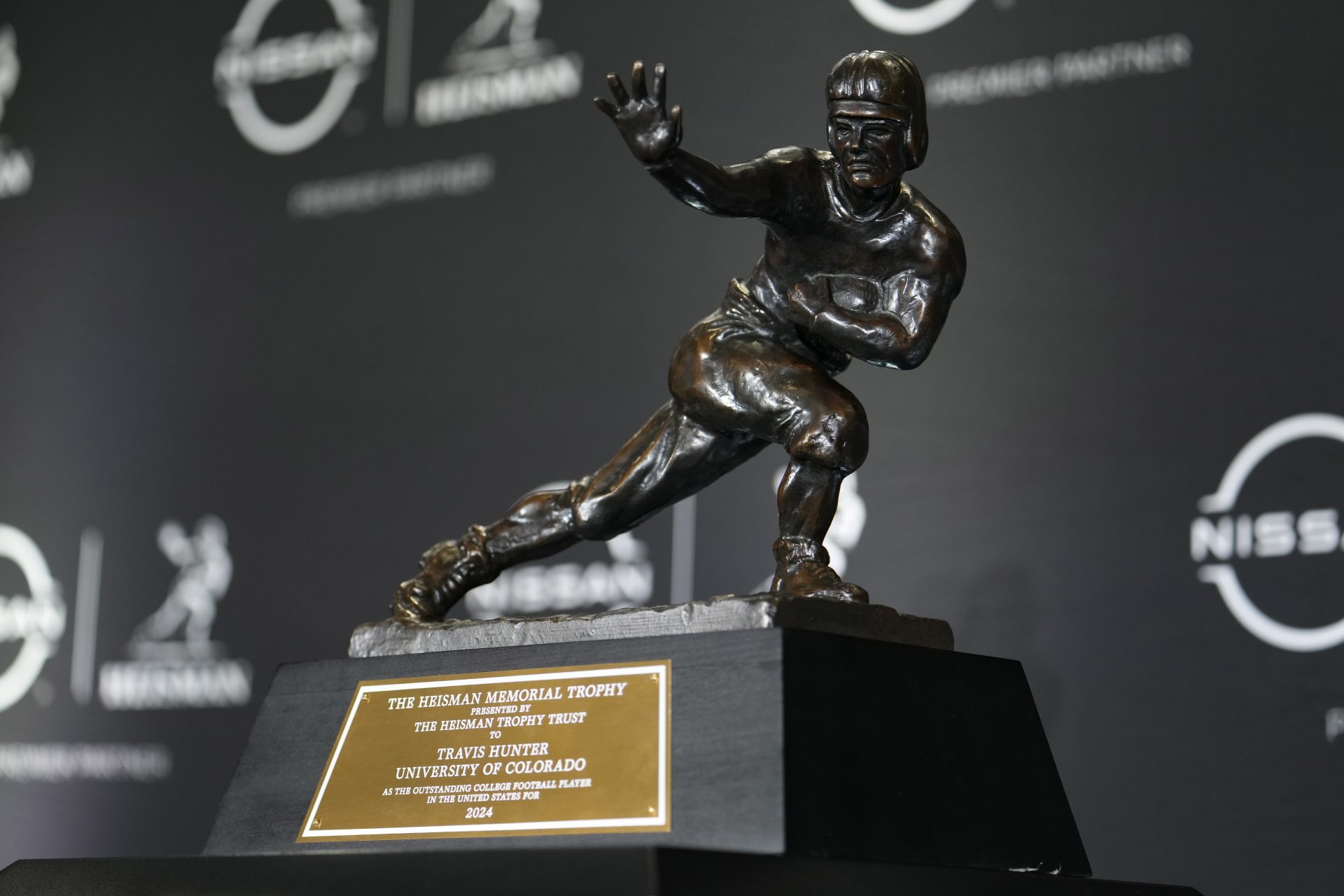The stiff arm. The lean. The tucked football. Even if you’ve never watched a full game of college football, chances are you’ve seen—or struck—the iconic Heisman Trophy pose. Every December, we watch a new college star hoist that bronze statue under a storm of flashbulbs.
However, few people know who that player on the trophy is supposed to be. Spoiler: it’s not a Heisman winner. It’s not even someone who played at a powerhouse football school. It’s a man named Ed Smith—a forgotten running back from NYU whose story is as fascinating as the award itself.

The Man Behind the Heisman: Ed Smith’s Accidental Fame
Let’s rewind to the 1930s, when football was still growing into the spectacle we know today. Ed Smith was a tough, talented running back at New York University, a team that was surprisingly competitive then.
NYU’s football program went head-to-head with schools like Alabama, Fordham, and Army, and Smith was one of its best players. He wasn’t a household name like Notre Dame’s Four Horsemen or Michigan’s Tom Harmon. Ed Smith had the raw power that caught people’s eyes, especially one man’s.
That man was Frank Eliscu, a sculptor and friend of Smith’s from their days at George Washington High School in Manhattan. When Eliscu was commissioned by the Downtown Athletic Club in 1935 to create a statue for a new football award, he didn’t want something generic. He envisioned a player in motion—dynamic, intense, and unmistakably athletic. And who better to help him bring that to life than his old buddy Ed?
Smith later described the moment like this:
“Frank had me pose in our old gym. He told me to tuck the football like I did at NYU and throw out a stiff arm like I was shaking off a defender. I didn’t think anything of it—it was just helping a friend with a project.”
Smith was still playing semi-pro football and working a regular job at the time. He had no idea that his moment of goofing around with a sculptor friend would eventually turn him into an eternal figure in American sports culture.
The Birth of the Heisman Trophy
The Downtown Athletic Club in Lower Manhattan created an annual trophy to honor college football’s most outstanding player in 1935. The first award went to Jay Berwanger of the University of Chicago, but the trophy didn’t have a name yet. When the club’s athletic director, legendary coach John W. Heisman, passed away in 1936, the award was renamed in his honor.
Congratulations to @CUBuffsFootball junior CB/WR Travis Hunter, the 2024 Heisman Trophy winner! #HeismanTrophy #MoreThanATrophy pic.twitter.com/a8RdGUONVf
— The Heisman Trophy (@HeismanTrophy) December 15, 2024
While Frank Eliscu crafted the trophy with vision and artistry, the pose was always meant to capture a specific kind of grit and athletic movement. The extended right arm, the tightly gripped football, the forward lean—it’s not just a cool stance; it’s a move that every running back has used to escape defenders. And Ed Smith did it so naturally that he became the perfect model.
But here’s the kicker—Smith didn’t even know his likeness was used for the Heisman Trophy until nearly 50 years later, in 1982. A documentary researcher stumbled upon the truth and contacted Smith, who was then in his late 60s and living a quiet life on Long Island as a commercial printer.
“I was shocked,” Smith said in a 1982 interview with The New York Times. “I had no idea all those years that people looked at me every time they saw that trophy.”
To honor his role, the Heisman Trust eventually invited Smith to that year’s ceremony, and he finally got to stand next to the trophy he’d helped inspire.
The Cultural Rise of the Heisman Pose
Over the decades, the Heisman Trophy has become more than just an award—it has become an icon. It’s unique, action-packed design sets it apart from almost every other trophy in sports, which often depict static figures or generic shapes. The Heisman, though? It moves—or at least, it looks like it’s about to.
Kids across America mimicked the pose in their backyards. EA Sports even featured it on the covers of its NCAA Football games. And in one of the most unforgettable moments in Heisman lore, Michigan’s Desmond Howard struck the Heisman pose after a touchdown against Ohio State in 1991, sparking controversy and legend.
By the 2000s, doing the Heisman pose became a rite of passage for college football stars. Even celebrities, politicians, and musicians have gotten in on the action, posing in photos or on social media as if they just stiff-armed a linebacker.
The Heisman Trophy may only go to one player yearly, but the pose? That belongs to the world now.
Ed Smith passed away in 1998, but his legacy lives on through every Heisman Trophy handed out, every highlight reel, and every backyard reenactment. He wasn’t a Heisman winner. He never played in the NFL. But in a way, he achieved something far more lasting—he became the face of college football excellence.
KEEP READING: What Do College Football Coaches Actually Do? Inside the Head Coach’s Daily Role
In a 1996 interview just before his death, Smith humbly reflected:
“I never got rich, never got famous, but I guess I left a little mark. Not bad for an NYU guy, huh?”
And that’s precisely what makes the Heisman story so special. It’s not just about stats or championships—moments, effort, legacy, and the quiet people behind the big stage who define it.
College Sports Network has you covered with the latest news, analysis, insights, and trending stories in college football, men’s college basketball, women’s college basketball, and college baseball!

